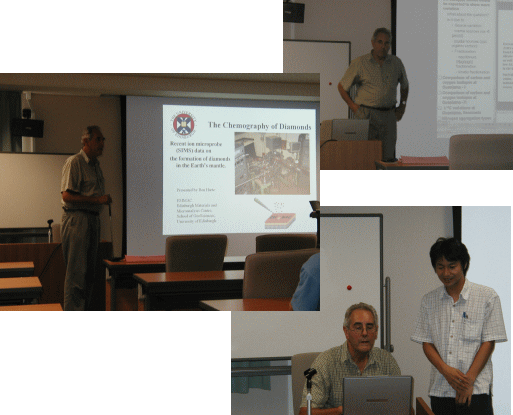"The Chemography of Diamonds:
recent ion microprobe data on the growth and composition of diamonds in the Earth's mantle."
Prof. Ben Harte
School of GeoSciences, University of Edinburgh, Scotland
5 September 2003@17:00-18:00
Meeting room, 6th floor, Advanced Research Building, Ehime University

@ The use of the ion microprobe or SIMS technique has made it possible
to determine chemical compositions for the individual growth zones shown
by diamonds, and therefore use chemographic relationships (spatially coordinated
variations in chemical composition) to unravel diamond formation histories.
Ion microprobe measurements on a wide variety of diamonds have been made
for carbon isotope ratios, nitrogen abundance and more rarely nitrogen
isotope ratios with a spatial resolution of 25 Êms.
In all cases there is a close correlation between growth zones (as shown
by CL images) and the abundance of N. Wide variations in Nppm are common
in closely spaced sets of concordant growth zones. These results urge caution
in applying the infra-red transmission technique (FTIR) for determining
N abundances and mantle residence times for diamonds. They also urge caution
in using bulk data to erect correlations between Nppm and Â13C. Where
the growth structure indicates a continuous phase of growth (either cuboid
or octahedral) the variation in Â13C is typically 4ñ even though major
variations in Nppm may occur during the phase of growth. In sectorial growth
cuboid and octahedral domains show differences of 2ñ. These relationships
within single diamonds do not support suggestions that differentiation
during growth causes a regular trend of Â13C and Nppm values (Cartigny
et al., 2001); nor do they suggest that fractionation during growth from
a source of limited composition gives rise to the variation of diamond
 13C values from ca. +3 to -35ñ (Galimov, 1991). In cases where major
changes in Â13C occur within single diamonds the growth patterns usually
indicate distinctly separate episodes of growth. This suggests that major
variations in Â13C are associated with discrete jumps in the compositions
of the C-O-H-N fluid or melt source for the diamonds. Present evidence
shows that the change of Â13C source composition is usually from one of
low values to more normal (nearer -5ñ) mantle composition. Such data may
be interpreted as implying a change from a subducted source (with organic
carbon) to an intrinsic mantle source, and this interpretation is supported
by oxygen isotope data on silicate inclusions in diamonds (Schulze et al.,
2003a).
@@@@@@@¨â¢í¹æF irifune@dpc.ehime-u.ac.jp TEL 089-927-9645
@@@@@@@Ú×îñFhttp://www.ehime-u.ac.jp/~grc/
åÃF¤Qåwn [_Ci~NX¤Z^[